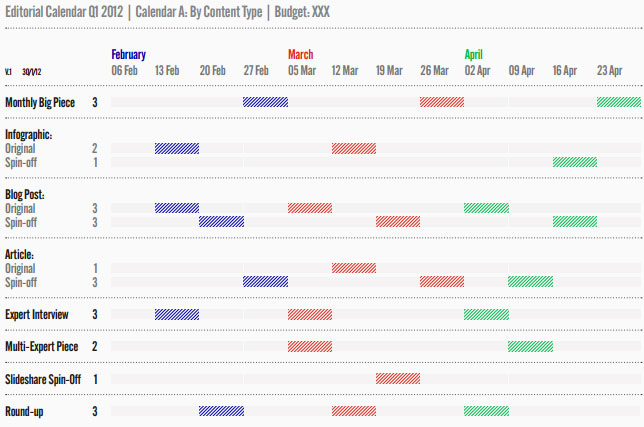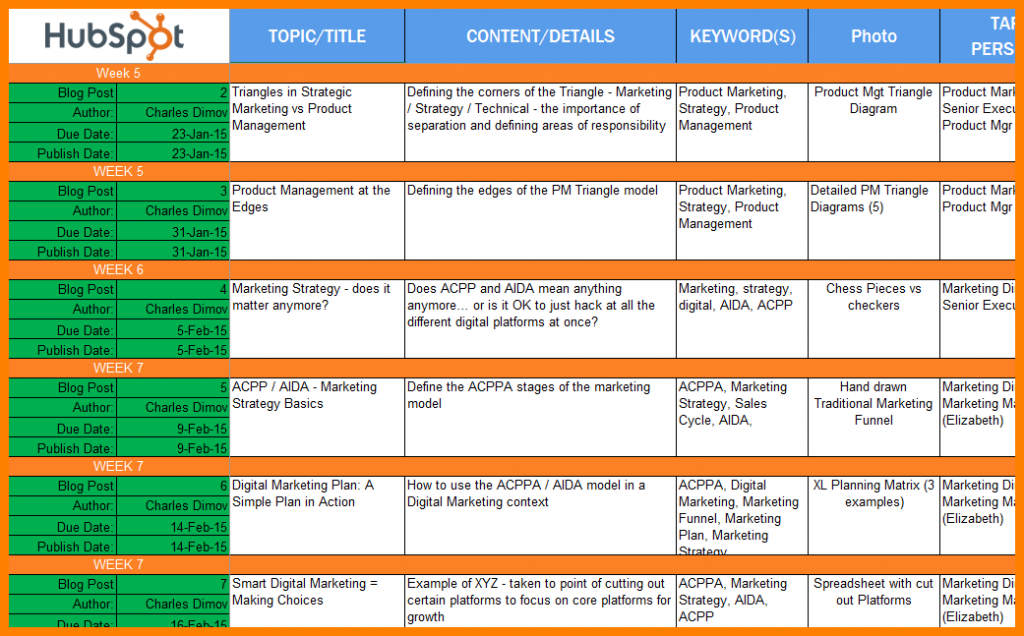It’s easy to find stories about businesses that jumped on the content marketing bandwagon, then jumped straight off.
They created a handful of 500-word posts, added them to their blog, promoted them on social, and kept it going for a few months while they waited for the promised inbound queries to arrive.
But nothing happened.
Why didn’t it work? Lack of focus, lack of topic discipline, lack of targeting, and lack of a plan
To avoid this trap, you need to see where you’re going and map how you’re going to get there.
A content or editorial calendar is an essential piece in the content marketing process. It’s a core management tool to keep execution on track. But it’s also robust enough to provide much needed structure when a full-scale strategy isn’t ready.
Getting started
A content calendar is exactly what it sounds like: a day-by-day, week-by-week calendar that details the content you’re going to produce, and when.
They centralise and organise your content marketing strategy, giving you a fixed point of reference against the busy backdrop of first drafts, approvals, SEO optimisation, social promotion, and CMS management an effective programme requires.
They save time and energy, keeping you organised and on track.
Most importantly, they stop content from getting repetitive or random by keeping the focus on your audience, responding to trends and changing in response to trends and feedback.
If you’re starting out the format really doesn’t matter. A standard spreadsheet will do, though for collaboration purposes using Google sheets, Excel online or Trello makes good sense.

Four steps to a great calendar
Step 1: Ideation
If you have a well-defined strategy this will be easier as a lot of the information you need will already be defined. If not, there are some key questions to answer about the type of content that fits your brand and target customer.
- What is your brand’s personality – and is it different online?
- How will content reflect that personality – or, will you diverge from it in order to address a specific or sensitive issue?
- What pain points, questions, or issues are prospective customers looking for help with?
- Where are the trusted sources of information in your industry, and where can you add value by adding your brand’s voice?
Step 2: Create the calendar
A screen full of blank rows and columns can be daunting. Start by populating the calendar with things you know are already agreed, and consider adding industry milestones like trade events, annual studies, key dates or commemorative days that can influence the timing and content of what you create.
That can include webinars, industry events, press releases, big branded content pieces like eBooks or industry reports & conferences you’re already confirmed for.
Here’s a sample of what it might look like:

Map out 1-3 months if the broader strategy is still being defined. Go for six months/two quarters if you have more activity already in the pipeline.
Step 3: Leave some blank spaces
A content calendar is by definition a proactive tool. So don’t forget to leave space for the ad hoc or reactive opportunities that relevant news and emerging trends can create. Perhaps it’s a huge merger between competitors, maybe it’s a consumer trend you want to have a point-of-view on. The weekly news cycle can throw up all sorts of opportunities for content around topics that are trending now.
Step 4: Observe and measure
Keep a close eye on content analytics. The calendar will be a living and breathing document, it’s fine to make course corrections. If something isn’t engaging readers, edit it or pull it. If one topic or asset is generating loads of interest, go back to brainstorming and think of new content executions that can maximise that audience.
Keep another close eye on the competition. They might be doing something right and there’s no shame in taking inspiration from elsewhere.
Finalising the calendar
Ultimately you want to have a mix of content lengths and formats to accommodate the preferences of different readers. Here is a suggested combination to get you started.
Write 1-2 long form blog posts per week
Put the time and effort into at least one well-researched and original long-form blog post. That means between 1,200 and 2,000 words.
A study by Medium says that articles of around 1,700 words actually draw the most reader time on the platform.
You will also want to have 1-2 shorter blog posts – and these are perfect for the reactive content mentioned above. But even though people want shorter pieces they can digest quickly, they’re also willing to stick with a longer article if they find it valuable.
Longer pieces establish you as a trusted source of good information, and be easier to re-use down the line.
Create monthly visual content
Infographics have proven to be a great way to share information visually. They add variety to your content and along with video, the format is highly share-able on social. In terms of volume they receive more downloads, embeds & engagement overall.
Go back over the statistics, anecdotes, study findings, industry news, and other factoids uncovered when you were researching blog posts and turn them into something impactful that tells a story your customers will find valuable.
If you don’t have an in-house designer, try a freelancer platform like People Per Hour, or an online service like Canva which makes it easy to create infographics from easy-to-use templates.
Publish a quarterly whitepaper
Whitepapers and ebooks are a great way to delve even deeper into a subject you’ve covered in one of your long-form blog posts. As they are weighty and in-depth they make great assets for content upgrades and lead generation campaigns.
They also provide a brilliant format for content recycling.
If you’ve written 5 or 6 long form blog posts on a similar subject, gather them together as chapters of an eBook, then post it to your website.
The bar is set high for eBooks now – they need to look good. So consider engaging a designer to bring it all together, or try Canva or a similar online service.
What happens now?
After each piece of new content goes live, promote it on social media, in your email newsletter, in PPC campaigns, or if the asset is rich enough like an eBook – create a dedicated landing page and use it to gather leads.
You can’t just publish, you have to distribute. Even if the content is brilliant, rigorously planned and SEO optimised, you’ll miss opportunities if you don’t actively promote it. Plug the ‘break’ dates and distribution channels for each piece of content into the calendar as well, to ensure the promotion piece isn’t missed out.
After that it’s a matter of measuring the effectiveness of each asset you’ve created. The KPIs for should be set according to the stage in the sales cycle the content is meant to influence. That can range from unique user sessions for blog posts meant to fill the top of the funnel, to leads generated, and sales converted.
Revisit the calendar regularly to make sure that everything is on track. A content marketing calendar can be an incredibly useful tool – making your job easier and demonstrating the thought process behind your work. Use it to full advantage.




